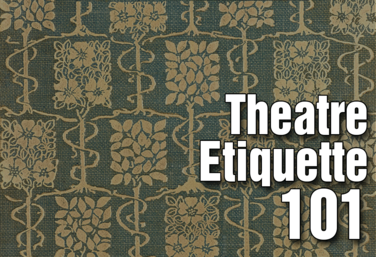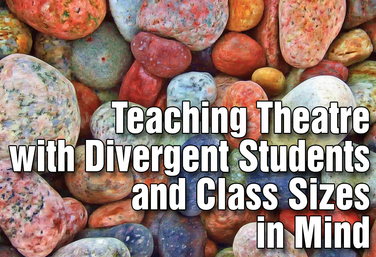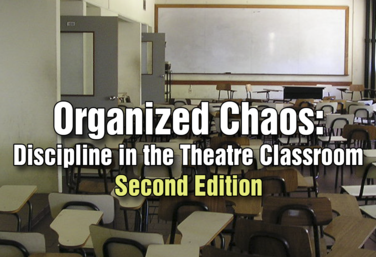View all Standards for Georgia Performance Standards OLD 2010 - Theatre Arts
TAMS6.11 Engaging actively and appropriately as an audience member in theatre or other media experiences
a. Models appropriate audience behaviors
b. Analyzes the relationship between an audience and a performer
c. Creates guidelines for behaviors appropriate to a theatre experience

UNIT
Theatre Etiquette
by Kerry Hishon
When teaching students who are brand new to theatre, it’s important to discuss and apply the expectations of the drama classroom and the theatrical world. How do you implement and instill theatre etiquette in your classroom and your rehearsals – before a show and backstage? A cohesive theatrical community starts with the rules and codes of behaviour both onstage and off.
Topics covered within the unit include: What is Etiquette, Real World vs Theatre World Etiquette, Audience Etiquette, Audition Etiquette, Pre-Show and Performance Etiquette. The unit ends with a culminating activity which included a rubric and reflection.
Read More
about Theatre Etiquette
Read Less
about Theatre Etiquette

PD COURSE
Theatre Etiquette 101
by Kerry Hishon
Instructor Kerry Hishon is an actor, director, writer, and stage combatant with years of experience in youth theatre. Her course, Theatre Etiquette 101, is designed to help students be successful in their theatrical journeys.
When teaching students who are brand new to theatre, it’s important to discuss and apply the expectations of the drama classroom and the theatrical world.
This course starts by explaining "what is theatre etiquette", and then moves through every step in the production process from audition to post-show recovery.
Every module has tips for both you and your students, classroom exercises, rehearsal exercises, and reflections. There are also printable posters included to use in your classroom or backstage.
Read More
about Theatre Etiquette 101
Read Less
about Theatre Etiquette 101
.png)
PD COURSE
Shakespeare's Toolkit
by Todd Espeland
Todd Espeland has the experience to know that having more tools in your toolbox makes you a better actor. This is especially important when teaching students how to approach Shakespeare. They need help breaking through the language barrier and into the character’s needs and into the character’s thoughts.
The tools that you’ll receive in this course will do just that. The course looks at scansion as a tool for breaking down Shakespeare’s verse, the importance of end of lines, and caesura. Caesura is an inner-line pause which is a lot of fun to play with and really, helps us provide insight to the character’s thoughts and into their needs.
The course provides numerous examples and handouts, and culminates in a performance assignment to use with your students.
Read More
about Shakespeare's Toolkit
Read Less
about Shakespeare's Toolkit

PD COURSE
Teaching Theatre with Divergent Students and Class Sizes in Mind
by Steven Stack
Have you ever wondered how in the world you can have a successful theatre classroom with so many variables that you have absolutely no control over? The two biggest ones being the size of your class and the students that you’re in charge of turning into some truly talented theatre geeks. This course by Steven Stack explores that wonderful and often ridiculous world of theatre classrooms while giving you the tools for you and your students to not only succeed but to flourish as well.
Lessons will include how to make any size class the Goldilocks class as in "just right", defining and working with all types of students you may encounter in your classroom, the seven must-haves of any theatre class, and the importance of structure in the theatre classroom by providing a guideline for setting up your day-to-day class time.
The course also provides tons of ideas, games and activities that you can use instantly in your classroom. So, if you’re a first-time theatre teacher or one just looking for new ideas, this is the course for you.
Read More
about Teaching Theatre with Divergent Students and Class Sizes in Mind
Read Less
about Teaching Theatre with Divergent Students and Class Sizes in Mind

PD COURSE
Rethink Pacing in the Drama Classroom
by Matt Webster
Pacing is one of the invisible hands of good teaching. Pacing is a fundamental component of a well run classroom. Many challenging issues that teachers face in the classroom stem from undiagnosed pacing issues: From comprehension to classroom management, pacing can be identified as both the source, and the solution of these problems. This course covers the Definition of Pacing, Non-Standardized curriculum, Pacing and Authentic learning, Expanding and Contracting The Pace, Transitions, Rehearsals and Hidden Pacing.
Read More
about Rethink Pacing in the Drama Classroom
Read Less
about Rethink Pacing in the Drama Classroom

PD COURSE
Organized Chaos: 2nd Edition
by Matt Webster
Organized Chaos: Discipline in the Theatre Classroom will give you tools and strategies to prepare you for challenges you may face as you step up in front of a class of students and introduce them to the art of theatre.
Whether you are a student teacher finishing college, a first-year teacher just starting out in the classroom, or an established teacher with a few years of experience under your belt, these lessons will provide insight and support as you establish discipline in your classroom.
This is a revised, 2nd edition of a favourite original course in the DTA, brought to you by experienced theatre educator, Matt Webster.
Read More
about Organized Chaos: 2nd Edition
Read Less
about Organized Chaos: 2nd Edition
View all Standards for Georgia Performance Standards OLD 2010 - Theatre Arts Standards Master List